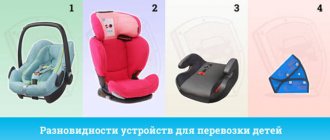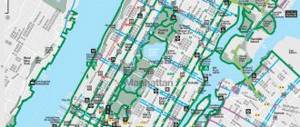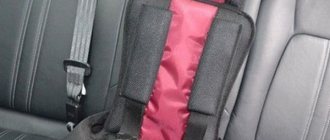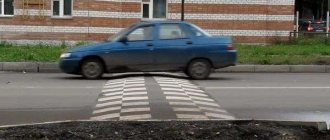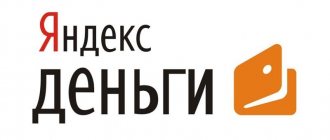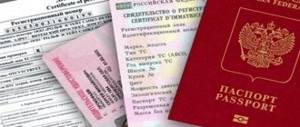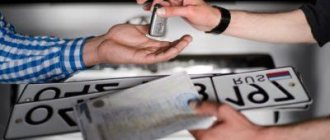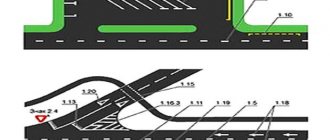What is a booster for children
A booster seat for children is a type of car child restraint system (CAC).
The main purpose is to artificially increase the height of a child in a sitting position to secure him with a standard seat belt, the standard design of which is designed for a person with a height of 150 cm.
The main function of a booster seat for children is to increase the safety of transporting children without the use of a full-fledged restraint device, which is achieved by complying with the following conditions:
- fixing the child’s position in the event of a possible collision using a stationary attachment of the pillow at three points;
- correct direction of the car seat belt - over the shoulder and hips;
- quick disembarkation of the child from the cabin.
It is an ergonomic seat with armrests, does not have a backrest or side protection, and uses the back of a car seat as a support. Subject to mandatory certification in accordance with GOST R 41.44 - 2005. or with the UNECE European Safety Standard No. 44-04.
It is allowed to place the booster in the direction of travel on the front or rear seats in accordance with the requirements of the operating manual for each individual device.
Booster or car seat?
A car seat is a safer means of transporting a child than a booster seat. All thanks to side protection, a five-point (or three-point) seat belt and a separate backrest. However, the booster is perfect for those parents whose child has already outgrown the seat, but cannot yet fasten with standard seat belts. Here are some other situations in which it is better to purchase a booster:
• You often travel with your child in rented cars or taxis. Thanks to its compact size, the booster can be easily taken with you. Save on car seat rental without compromising the safety of your child. By the way, some boosters weigh only 750 grams and fit into a handbag!
• Do you love to travel. Traffic regulations require that a child under 7 years of age be transported in a restraint system. However, in many cities in our country (and in other countries) it can be difficult to find a taxi with a car seat. You have to make a difficult choice: get to the hotel by public transport or neglect the safety of the little person. The lightweight and compact booster can be taken with you on board an airplane or train and used at your destination.
Follow traffic rules: carry children in booster seats and car seats. Good luck on the roads!
At what age can a booster be used?
In accordance with clause 22.9 of the Traffic Regulations of the Russian Federation, the transportation of children is permitted:
- up to 7 years old - only using a child restraint system;
- from 7 to 11 years old - in the front seat - only with a child restraint system, in the rear - it is allowed to use only standard seat belts, without additional devices;
- from 12 years old - only seat belts are allowed.
In addition, the rules establish that each of the devices used must correspond not only to the age, but also to the weight and height of the child.
Depending on the age and weight of the child, in accordance with UNECE No. 44-04, all restraint devices are divided into groups:
- 0 – from birth to 6 months and weighing up to 10 kg;
- 0+ – from 6 to 12 months (up to 13 kg);
- I (1) – from 9 months to 4 years (9 – 18 kg);
- II (2) – from 3 to 7 years (15 – 25 kg);
- III (3) – from 6 to 12 years (22 – 36 kg).
A child booster seat without a backrest, in accordance with the amendment made to the UNECE Uniform Regulations No. 44-04 in 2021, can only be used as a restraint structure for group III (3).
Thus, it is allowed to use a booster to transport a child aged 6 to 12 years only in the back seat of a car, and its weight must be between 22 and 36 kg, and its height must be at least 125 cm.
In this case, you should consider the option of a booster when transporting a child over 12 years of age, provided that his height is less than 125 cm, since the standard seat belt should be at shoulder level and in no case in the neck area.
At what age is it legal to switch from a car seat to a booster?
The relatively low price of boosters allows you to change models as the child grows. It is recommended to be guided by the same criterion when the question of changing a car seat comes up on the agenda, because if the child is as comfortable as possible in it, then there is no need to rush to change it.
If, on the contrary, he is clearly cramped in the seat, then it’s time to think about a booster, which will make the experience of the trip practically no different from that of adults. That is, in some cases it makes sense to be guided not by the child’s age, but by his weight, dimensions and comfort.
Also read: at what age can you use a “corner” for fastening a child.
Another thing is that the baby must be at least 3 and no more than 12 years old, because car seats for children were developed specifically for this age category, not excluding the use of a chair if it is still comfortable.
If the child is already 3 years old, then this is not a reason to quickly seat him in a chair. Instead, it is strongly recommended to measure its basic physical parameters, remembering that the optimal values for transplantation from one device to another are 15 kg of weight and 120 cm of height, without which it is better not to rush.
Requirements from traffic regulations
The decision regarding the transportation of children was made back in 2021, and according to it, from the moment of birth until the age of 11, a child can travel in a vehicle exclusively in a special device, which can mean both a car seat and a booster.
It is strongly recommended not to choose a booster without a child
This means that the choice between a full-fledged chair with a backrest and a seat is a personal matter for parents; another thing is that, due to physiological characteristics, you certainly can’t carry babies in a booster seat, so it still makes sense to use the chair at the first stage, transferring the child to the seat no earlier than three years of age.
In addition, the traffic rules provide for certain relaxations for children over 7 years old, which provide for the use of seat belts only if the child travels in the back seat.
In front, it will be necessary to transport a small passenger exclusively in a restraint device, and so on until the age of 12, when you can already limit yourself to belts alone.
Selection by weight and height
For those who are not sure about choosing the optimal device for transporting children, it is worth giving some practical advice. And first of all, we are talking about the fact that in addition to boosters without a back, you can easily find devices with this part on sale, made in the form of a compact chair. By the way, this model is ideal for transporting thin, short children who are much smaller than their peers.
If the child is large and also mobile, then a seat without a backrest will be more suitable for him, the role of which will be played by the internal equipment of the car itself. As for the fixation, in both cases it will be equally reliable, assuming a rigid attachment to the car seats. But the child will be fastened in different ways: with the straps of a booster, made in the form of a high chair, or with the straps of the car itself, if you only have to use one seat without a backrest.
The upholstery material is also of great importance, and if possible, it is better to give preference to natural, breathable materials.
In addition, it is strongly recommended not to choose a booster without a child, who must be seated on the device before purchasing it, choosing a model for growth.
If we talk about fastening systems, today the most common ones are the American Latch with carabiners, the European Lsofix with brackets, as well as the ideal Top Tether anchor mechanism for infant carriers, despite the fact that they all have their own advantages.
Booster markings
When choosing a booster, you should pay attention to its markings; if there are no markings, it is better not to buy such a booster. The marking, or simply the sticker label, carries important information.
Labeling of a children's booster is carried out in accordance with UNECE No. 44-04 and must have the following designations:
- color – orange or white;
- ECE-R44/04 – mark of product compliance with the safety standard;
- 22 – 36 – user weight category;
- 04 and further six-digit code – individual number of tests performed;
- E1-9 – a sign of official safety approval provided by one of the European countries;
- III – retention device group (Roman or Arabic numerals can be used).
Recently, booster packs were labeled “2/3”, indicating that the booster is designed for a child weighing from 15 to 36 kg. Nowadays, the use of boosters is prohibited for such young children, since their spine is not yet strong and they need lateral support. The booster is approved for the age group designated “3”, that is, for children weighing from 22 kg and height from 125 cm. The “2/3” marking is outdated and was canceled in 2017.
What it is
A booster seat is a backless device designed to carry a small child in a car. The main differences from a classic car seat: in this device, the baby rests directly on the back of the car seat and there are no additional seat belts. A standard car seat belt is used to secure the child. Installing a booster seat is appropriate for small children so that they can be held securely in place by a standard seat belt. This device allows children to be comfortable in the car due to the fact that the seat has lateral support, allowing it not to slide to the side when turning.
The main advantage of boosters compared to car seats is their low price, as well as lower weight.
Booster material for children
The material used in the production of the booster determines its strength, long-term use and cost.
From foam plastic
Foam boosters have the following advantages:
- do not get wet;
- resistant to microorganisms (can be stored in a cold and damp place);
- have a small weight - up to 2 - 3 kg;
- have a low cost - up to 1000 rubles.
As a disadvantage, it is necessary to note the fragility of the material, and, as a result, the low level of protection, since when exposed to force, the foam does not hold its shape and crumbles.
Made of plastic
Boosters made of plastic have all the advantages of foam and are relatively cheap - their cost is 1500 - 2000 rubles. During sudden braking, they reliably hold the child in a fixed position, but in the event of an accident, an additional risk may arise - the material breaks into thin and sharp parts.
With metal frame
The disadvantages of a booster with a metal frame are its heavy weight and overall dimensions, but they do not matter when compared with the advantages:
- high degree of protection;
- resistance to impact;
- reliability of fixation.
In addition, such a booster has increased comfort, since its interior consists of several layers of polyurethane foam, which retains the shape of the body and gives softness.
Pros and cons of boosters
Using a baby booster undeniably has some advantages:
- comfortable placement of a child, especially at the age of 10 - 12 years;
- low cost - from 700 to 3000 rubles. depending on the material of manufacture;
- compactness;
- light weight – up to 5 kg;
- ease of installation and dismantling.
The booster has one drawback, but it plays a decisive role when choosing a child restraint system - the level of protection in the event of a possible accident is significantly lower compared to a child car seat due to the lack of lateral impact protection.
How to choose a booster
When choosing a child booster, it is necessary, first of all, to focus on the safety, reliability and comfort of placing a child in the cabin.
Frame material
The frame material is hard: metal or plastic. In this case, the following conditions must be met:
- the pillow filler should be soft and hold the shape of the body;
- the surface of the seat should be evenly covered with ergonomic filler;
- The leading edge of the booster should be soft and sloping.
In addition, there are no obvious frame protrusions around the entire perimeter of the device that would impact a child under normal conditions.
Case material
Preferred characteristics of the cover material: wear resistance and hypoallergenicity. The use of natural fabrics that do not cause sweating and are able to absorb moisture increases the child’s comfort in hot weather. The removable cover guarantees timely cleaning and washing.
Armrests
The metal frame of the armrests should be covered with soft filling to create comfort. To reduce the risk of injury, the only condition must be met: the height of the armrest must correspond to the free position of the child’s arm, bent at a right angle.
Dimensions
The overall dimensions of a booster seat for children must correspond to the size of the child, since this is the basis for safe transportation:
- The length of the seat should be equal to the length of the legs with bent knees with full contact between the child’s back and the back of the car seat. If the length of the booster is longer, the child’s legs will be straightened, which is contrary to safety conditions. In addition, by bending his legs, the child will roll his back along the back of the car seat, which will lead to the seat belt moving from the shoulder to the neck or head - this position is strictly unacceptable. A similar situation will arise if the length of the seat is shorter - the lack of comfort will encourage the child to slide down the back.
- The width of the booster should correspond to the size of the child, taking into account the presence of warm clothing. Squeezing the body will cause pain, and the presence of free space will not allow you to securely fix the position.
Thus, before purchasing, it is advisable to place the child on the booster and check the compatibility of the sizes.
Seat belt corrector
The corrector is used to prevent the seat belt from moving in the event of an emergency. It is a triangular envelope that pulls two standard belts together. Required when the belt strap slips off the child’s shoulder and does not return spontaneously.
It can be used in extreme cases as an additional measure in conjunction with a booster, but is not an independent restraint device, since it shifts the calculated load on the belt and weakens its tension.
Mounting method
The safest way to secure a child booster seat in the cabin is the ISOFIX or LATCH system. It is certified and allows you to securely fix the booster on the car seat.
It is allowed to place the booster in the cabin using seat belts without additional fastening, however, this significantly increases the risk of injury in the event of an emergency.
Child's opinion
The child’s opinion is an important factor when choosing a booster, since only he himself will identify possible inconveniences in use:
- the presence of protruding parts of the frame;
- hardness or excessive softness of the seat;
- squeezing on the sides.
In addition, during testing it is necessary to check the compliance of the armrests and seat length with the child’s size, and also to identify the need to adjust the seat belt.
Main characteristics of the booster
A booster seat is a substitute for a child's car seat, but without a backrest, with only armrests. The devices are made of foam plastic, but more often plastic or based on a metal frame with soft polyurethane and foam parts covered with fabric.
Of all, you should choose those that are fixed using special fasteners to the metal parts of the car (Isofix or Latch), and not just fastened with a standard belt to the car seat. They are more convenient and reliable
Therefore, when choosing, you need to pay attention to the method of fastening, as well as the height of the armrests, the position of the belt (it should go over the shoulder). It is better to buy a booster seat with a backrest to provide maximum comfort to the passenger.
A high-quality device is attractive because it is easy to take out and install, and can be used in a small car and with two or three children. That's why taxis almost always have boosters. They are also useful for infrequent use of the family car and short trips.
Child seat without backrest: main types
A child seat made without a backrest comes in three versions, which differ in materials and characteristics:
When choosing a car seat or booster seat, you should keep in mind several nuances:
- the presence of devices for rigid fixation on the car seat, that is, Isofix or Latch systems;
- The height of the armrests must be sufficient to allow the lower strap of the seat belt to be properly secured and thus reduce the likelihood of it squeezing the passenger’s legs in an accident;
- The width of the car seat should be such that the baby does not feel cramped on it even in winter clothes;
- It is desirable that the pillow has a detachable top part, then it can be removed and cleaned.
The presence of devices that allow you to remove the car belt from the face of a young passenger is not necessary. These fasteners do not perform their function well and quickly fail.
We recommend reading about the rules for transporting children in the front seat of a car. From the article you will learn about the age at which a child can sit in the front seat, transportation rules, and types of car seats.
And here is more information about fines for driving without a child seat.
What is a booster in a taxi
A booster seat in a taxi is a replacement for a child car seat, mandatory for transporting a child if he is under 12 years old. The device does not have a backrest, but has armrests, it is attached to the seat and must be used in conjunction with car seat belts. So this is sufficient protection in case of an accident.
The driver may be fined for not having the device when there is a passenger under 12 years of age in the car. Therefore, when ordering a taxi, you need to inform that a child will be taking part in the trip, tell the dispatcher his height, weight, and how old. The parameters are necessary to choose a device that is convenient and truly capable of protecting.
Compact booster for a car: pros and cons
A compact booster seat is sometimes preferable for a car with a child in it than a full-fledged child seat, as it has the following advantages:
- if it is of good quality, then it is quite reliable, but costs less;
- has a low weight (up to 2 kg), so if necessary, it can be easily pulled out of the cabin or moved from one car to another;
- due to its small dimensions, it will not interfere with the transportation of adult passengers, and there is no need to remove the device;
- for the same reason, you can carry two children at the same time, since both boosters will fit in the back seat;
- if it is soft and well selected, the child will be quite comfortable;
- can be used in winter, when a child with thick clothes does not fit in a standard car seat.
Mifold Compact Booster
The disadvantages include:
- lower level of comfort compared to chairs, especially for small children;
- cannot be used if the child’s weight and height do not yet correspond to certain values;
- full-length restraints provide better protection in the event of an accident.
Is the booster safe for a child?
A booster for a child is absolutely safe if:
- it is multi-layered and the upper part is soft;
- fits true to size;
- Well secured to the car seat.
Be sure to use it in tandem with a holding belt. Then the device not only will not cause harm, but can save you in a threatening situation.
Safety: differences between a booster and a car seat
Comparative characteristics affecting safety are given in the table:
| Index | Car seat | Booster pillow |
| Fastening | 5 points | 3 points |
| Rigid back for impact protection | There is | No |
| Side protection | There is | No |
| Head protection | There is | No |
| Fixation | tough | medium or low |
Thus, a car seat is a safer way to transport a child. It is recommended to buy and use a booster in the following cases:
- if the child is large and it is not possible to choose a chair;
- upon reaching 10 years of age;
- for taxi rides.
It is important to remember that mismatching the size of the booster significantly reduces the level of safety.
How to install a booster in a car
Installing a booster for children in the cabin consists of several stages and looks like this:
- clear the mounting holes on the car seat;
- install the booster tightly, secure;
- check the reliability of fixation;
- sit the child upright, place his hands on the armrests;
- fasten with a standard seat belt;
- Check that the seat belt is positioned correctly across the shoulder and hips.
If there are nuances when installing individual booster models, they will be reflected in the instruction manual - you should definitely read it.
The safety of a child when using a booster is significantly lower than when transporting him in a car seat. However, in some cases it is advisable to buy just such a device. The main rule is not to save money and choose a model responsibly.
The best place for a booster seat in the car
There are several areas in the car, the level of potential safety of which allows you to place a child here. These places were found taking into account statistical data on accidents involving children; the analysis also took into account injuries and their degree of complexity.
One of these places is behind the driver's seat. Here the risk of damage is minimized, especially in frontal collisions. The driver will turn the steering wheel in such a way as to avoid an impact from his side.
Another place is the center area in the back seat. This factor can be explained by the fact that no matter where the driver turns the steering wheel during an accident, the impact falling on the rear of the car will have no or minimal effect on the child.
It is prohibited to carry children in a car with a booster seat in the front seat. If the airbags are turned off, the risk of injury in the event of an accident is very high. Even the simplest ride on smooth asphalt with a child in the front seat will cause him a lot of inconvenience. This can easily be explained by the design features of the front seat - the developers take into account the anatomical features of adults, but not children.
